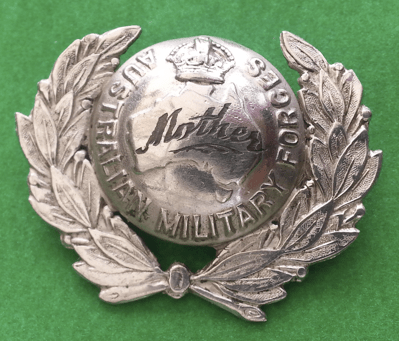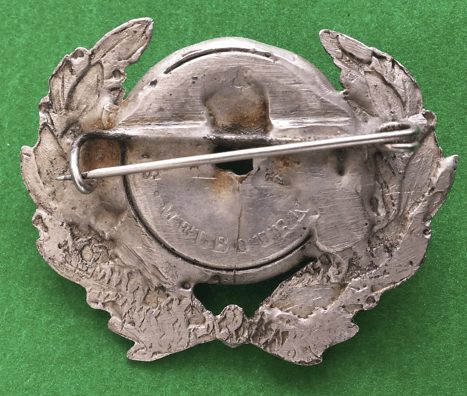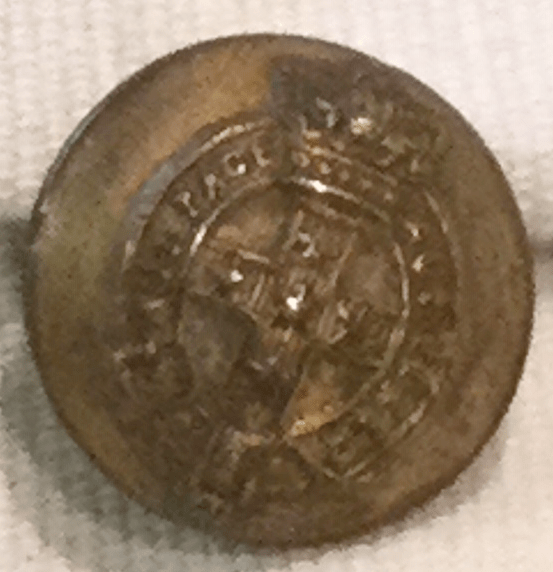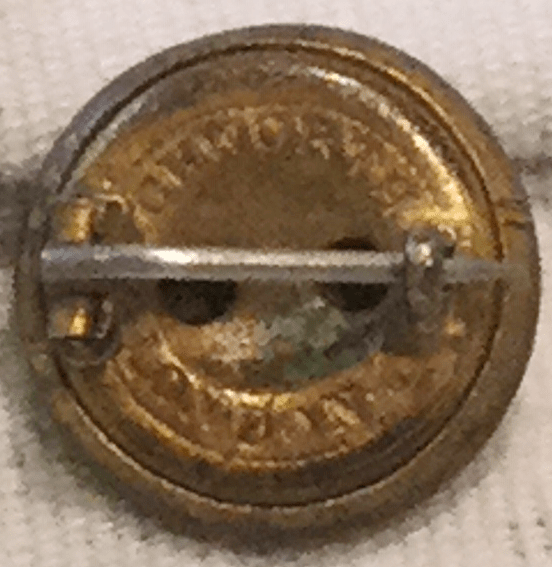Table of Contents
Trench Art

Sydney Mail, 8th September 1915 page 14.
The broadest definition of this term relates it to objects made by soldiers (including returned or convalescent soldiers), POWs, and civilians as souvenirs, momentos or gifts, to while away time, to make money, to aid in rehabilitation, and to try to make sense of the experience of war. i.e. where the manufacture is directly linked to armed conflict or its consequences. Although the term ‘trench’ relates to WW1, such objects have been made since the Napoleonic wars, if not for as long as there have been wars.
The book ‘Buttons & Sundries’ by Vittoria de Buzzaccarini and Isabella Zotti Miniciin 1990, referring to WW1; ‘Soldiers on all fronts were the involuntary “creators” of small objects, including aluminium or leather buttons, those most prized being ornamented with bits of stained glass fro burnt-out cathedrals, the sad keepsakes of a sorrowful period.’
Some have used uniform buttons, like the example below where a button and casing have been assembled into a cigarette lighter. A fellow club member has an identical item, so that he feels it may be an example of manufacturing work provided for returned soldiers.
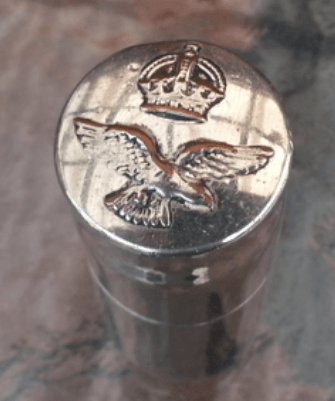
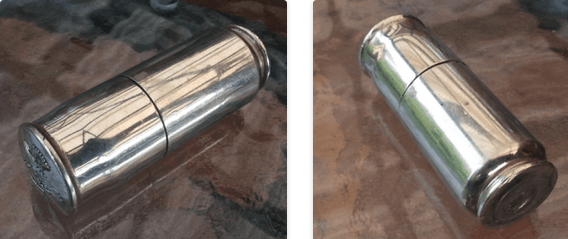
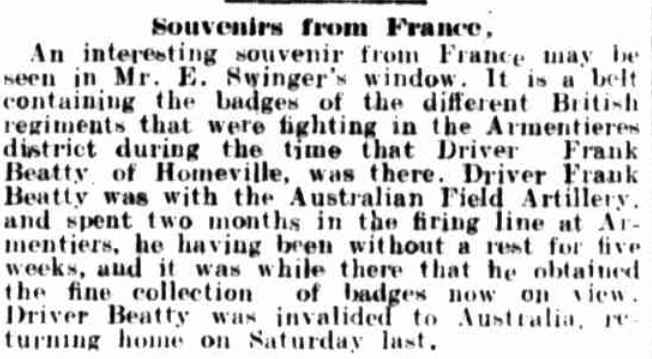
The Maitland daily Mercury (NSW), 4th October 1916 page 4.
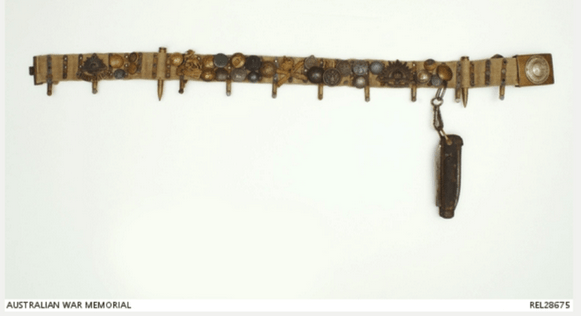
An example from the Australian War Memorial of such a belt. See https://www.awm.gov.au/collection/C959806
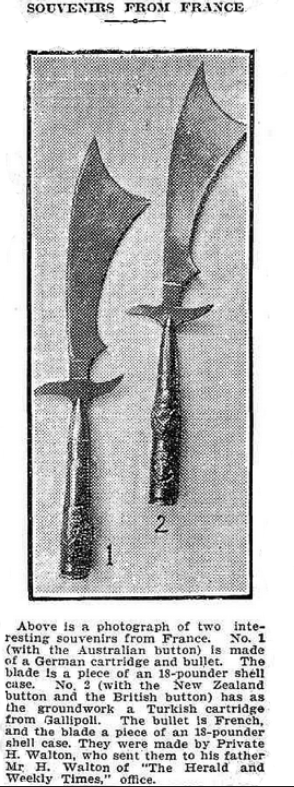
The Weekly Times (Melbourne), 24th March 1917 page 37.
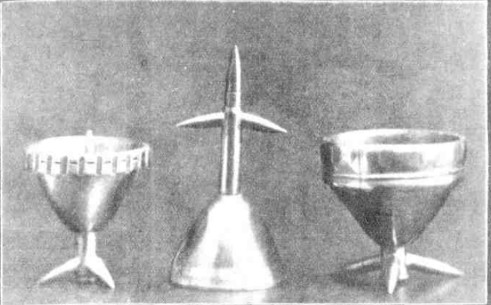
Sydney Mail, 1st August 1917 page 11, “Novelties from the Battlefield”, an ashtray, dinner bell and sugar basin.
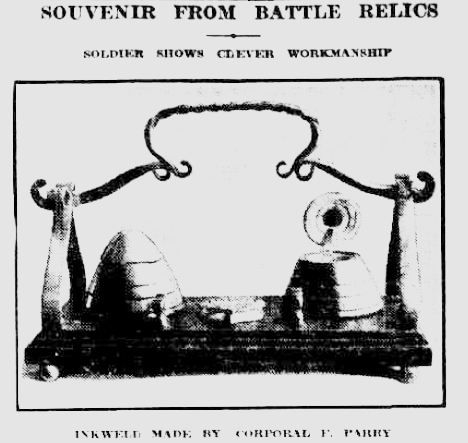
The Herald (Melbourne), 16th March 1918 page 8. The inkwell is made from wood from the Ypres Cathedral, plus English and German shells using only a hammer, file, knife and needle.
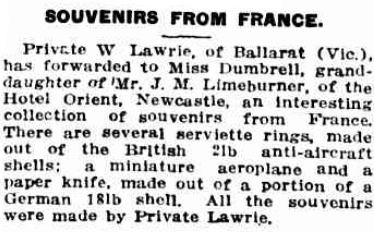
Newcastle Morning Herald and Miners’ Advocate, 4th October 1917 page 5. Example of such trench from the Australian War Memorial are shown below.
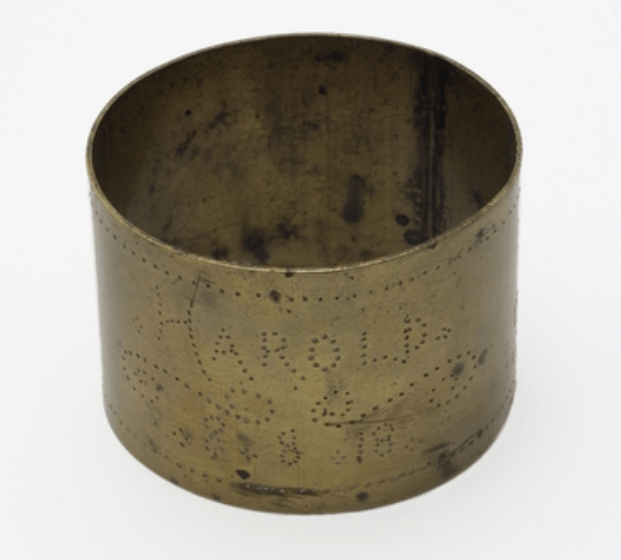
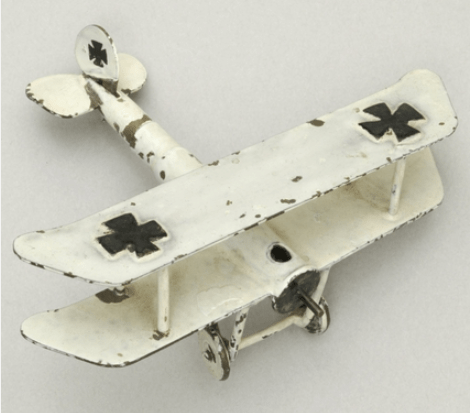
Uniform buttons and badges were collected, gifted, swapped, made into trench art, sweetheart brooches and sewn onto belts. The following story from 1915 was supposedly related by a French reporter describing how both French and British troops made collections of buttons.

Singleton Argus (NSW), 4th September 1915 page 3.
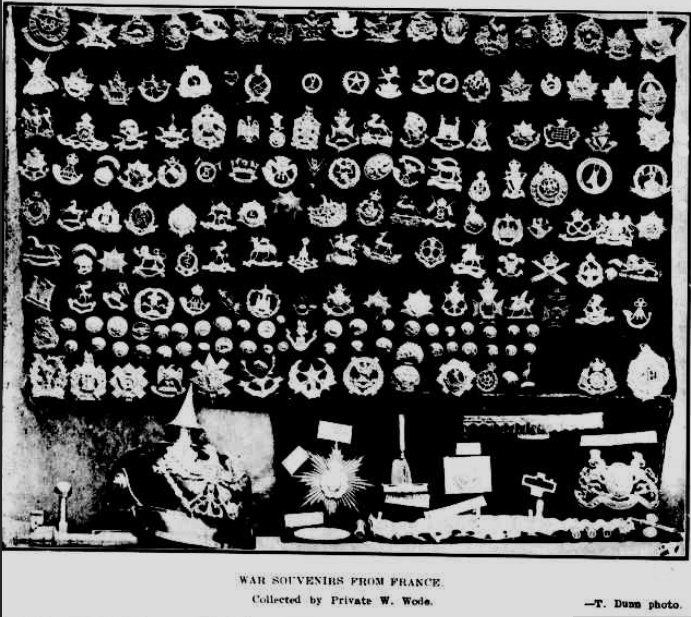
The Queenslander, 30th March 1918 page 27.
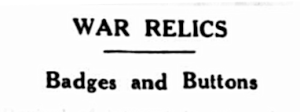
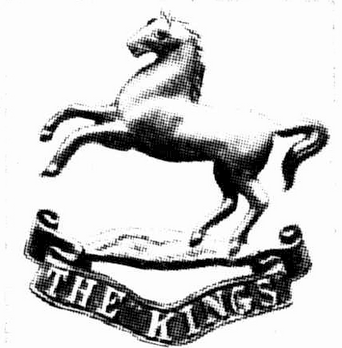
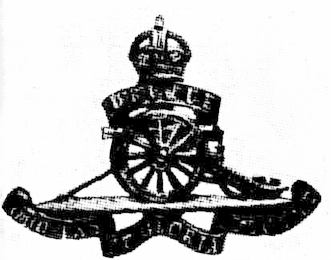

The Daily News (Perth), 4th April 1940 page 9.
The Australian War Memorial has some photos of a soldier making buttons and costume jewellery from cowrie shells. This presumably gave them something useful to do during quite periods.
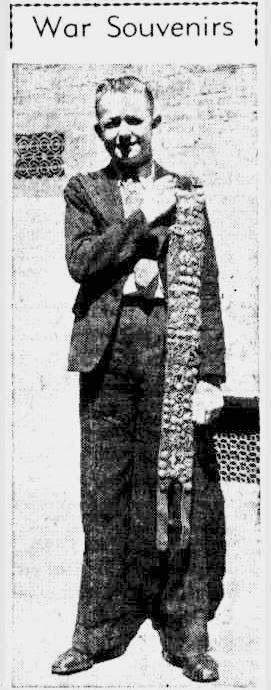
The Telegraph (Brisbane), 17th September 1941 page 4.
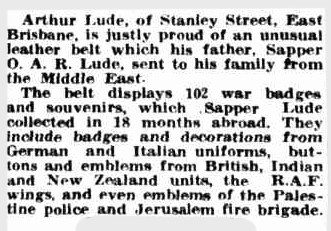
Loyalist token
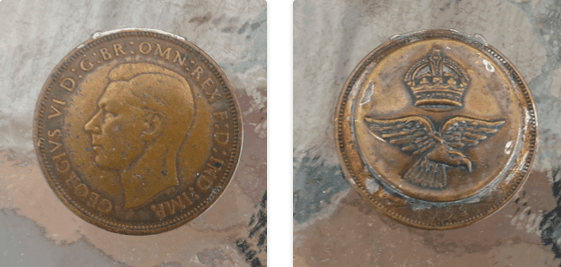
Made from a penny showing King George VI head and a RAAF button.
Sweetheart Jewellery
Sweetheart jewellery was/is a piece such as a hatpin, brooch or ring worn as a momento of a loved one serving in a theatre of war, or otherwise away from home. They could be home-made or bought from a professional jeweller. Uniform buttons were very suitable for making into these tokens.
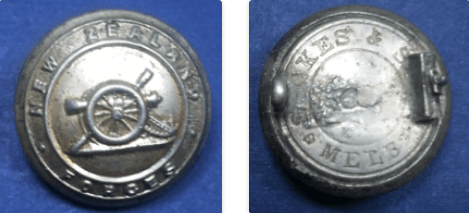
New Zealand Artillery button.
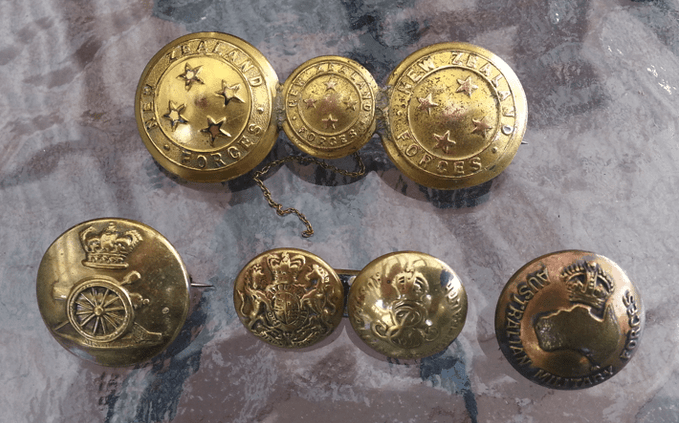
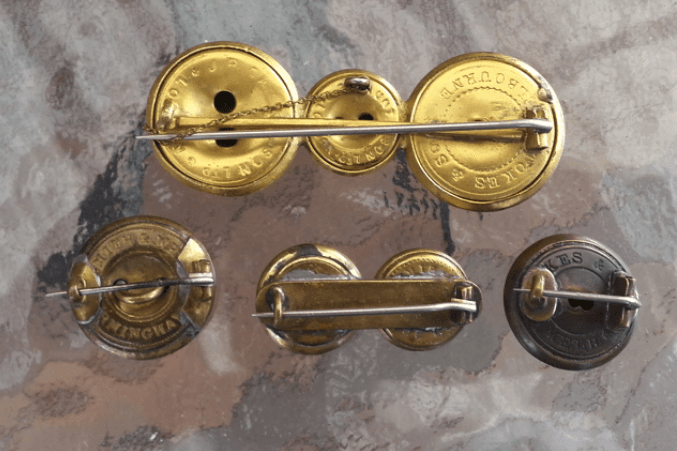
Backmarks Top L to R : J.R Gaunt & Son, London x 2, Stokes & Sons Melbourne. Bottom L to R: Smith & Wright Birmingham, obscured, Stokes & Sons, Melb.
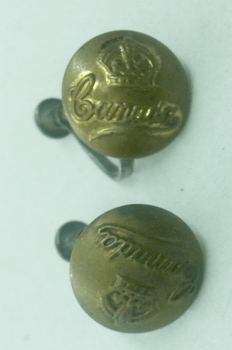
A pair of Canadian uniform buttons made into earrings.
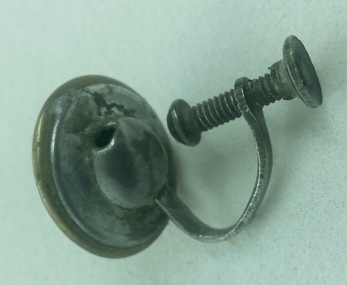
New South Wales Forces brooch.
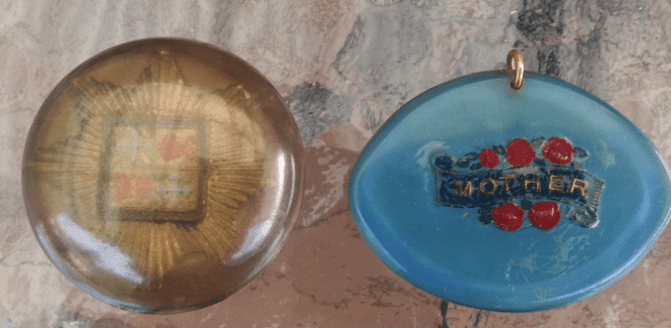
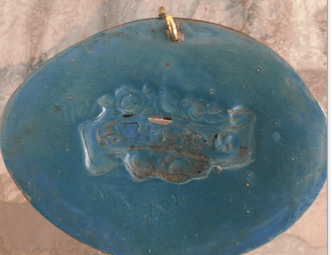
WW2 era perspex jewellery.
Patriotic buttons/jewellery

The Mail (Adelaide), 9th December 1916, page 13.
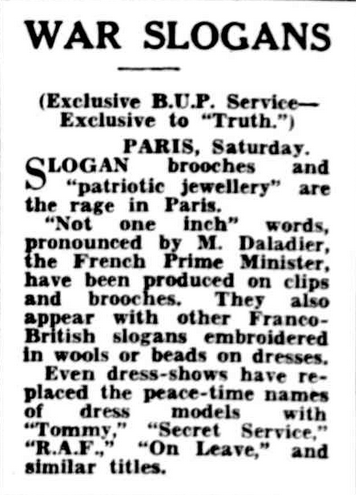
Truth (Brisbane), 3rd December 1939 page 20.
Some examples designed “to cultivate a national spirit, and help in a small way to build our great Australian Commonwealth ” (Watchman, 25th September 1913) are shown:
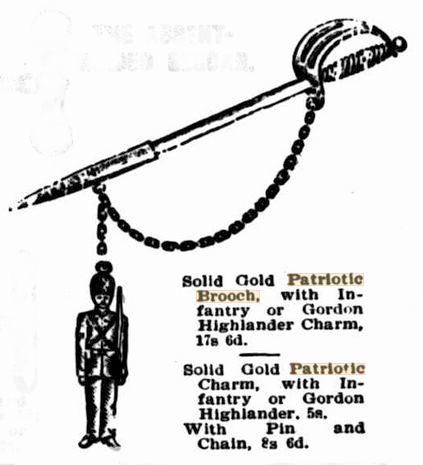
1900
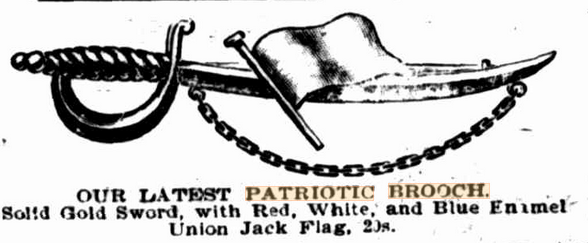
1900. Inspired by the Boer Wars.
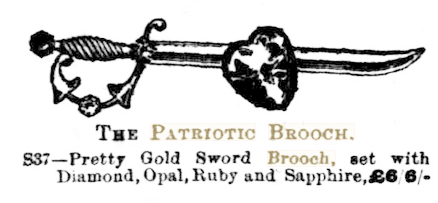
1900 “Red, white and blue” was represented by ruby, diamond and sapphire.

1914 Horseshoe, for luck, expressed a wish that loved ones would be lucky enough to return.
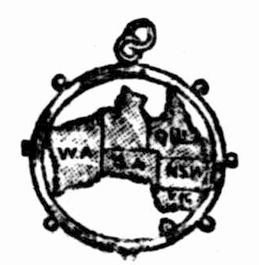
1915. Patriotic pendant.
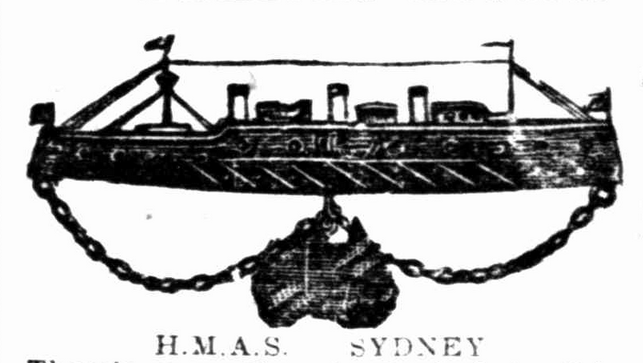
1916
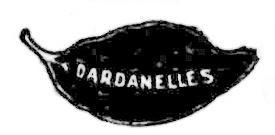
1916. This brooch was enamelled with a photo holder on the back.
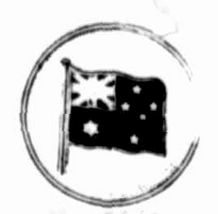
1922. Enamelled silver brooch.

1941
Similar to sweetheart jewellery, but not as personal, were buttons or jewellery professionally made to show your patriotism, and your general support of the troops/war efforts. A picture of a wonderful set found in Idaho was shared with the Victorian Button Collectors’ Club, with the owners wondering if they were made here.

Each button symbolises one of the allied countries: USA, UK, China, Australia and Russia.
For the record, I don’t think it is, as the construction (celluloid with embedded steel loop shank) is not something I have seen made by any Australian manufacturer. However, the set is fascinating. The card they were sewn on was labelled as “Allied Forces of WWII” and depicts the USA, Britain, China, Australia and Russia. This dates the buttons as 1941 or after, as that is when Russia joined the Allies.
Hatpins
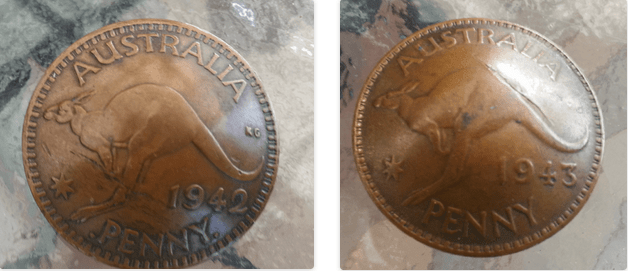
Pennies from a year of war, fashioned into hatpin tops.
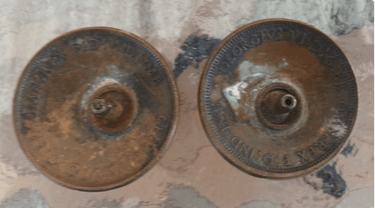
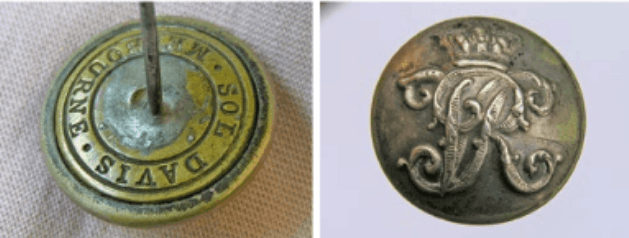
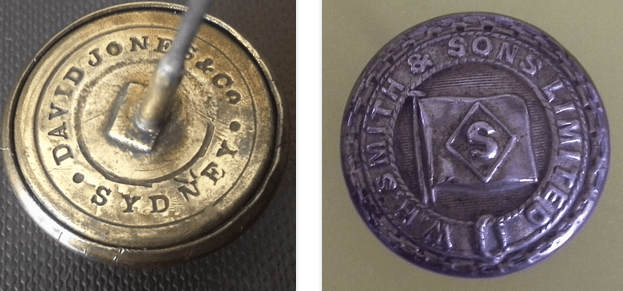
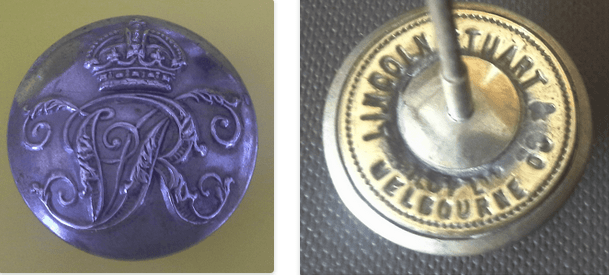
It was described in a 1907 story that during a souvenir collecting craze in America girls were “collecting” (stealing) uniform buttons and that “many of them show proudly a collection of hat pins made from the uniform buttons “. Therefore not all “sweetheart jewellery” was actually owned by a bonafide sweetheart!
Cuff-links
These could be made as a momentos by returned or retired soldiers and sailors.
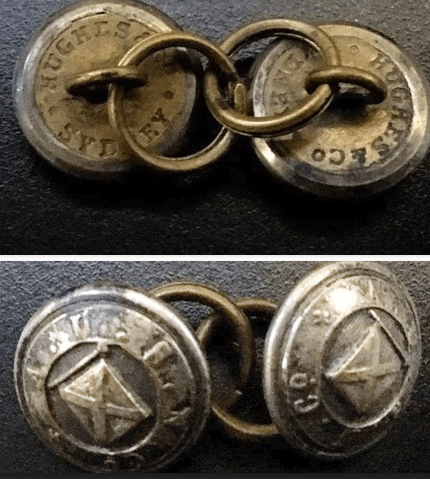
Miscellany
Compass “Escape” Buttons
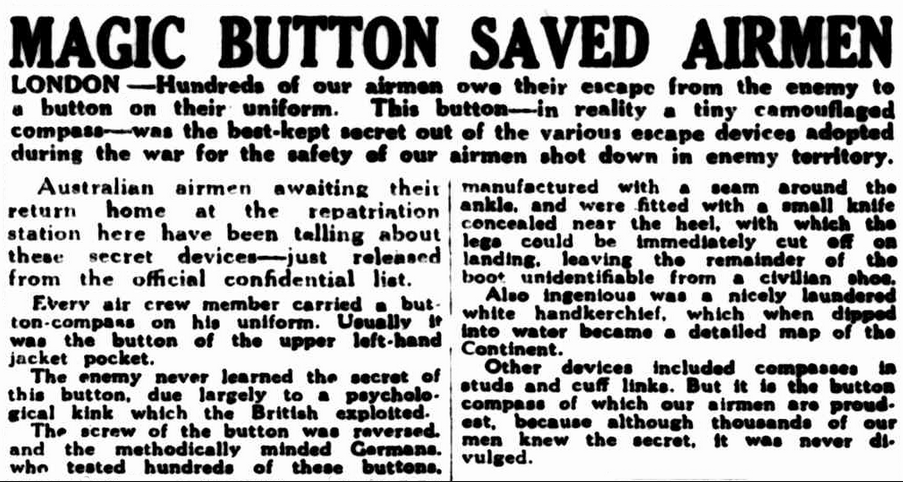
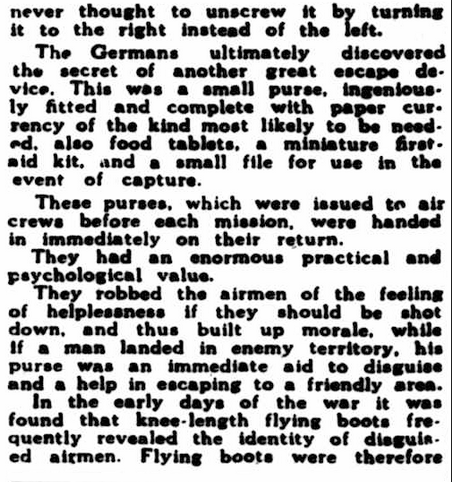
Army News (Darwin, NT), 12th September 1945 page 3.
For a Canadian version of this button, see https://www.historicflyingclothing.com/en-GB/escape-compasses/rcaf-escape-evasion-compass-button—rare-small-size/prod_17309#.X8rTv6lS-V4
Compass buttons came in varying forms. Some were fashioned in the form of magnetised trouser/shirt buttons, marked only with two dots for north, and one for south. When dangled from a string, they would give the direction. Other forms required two buttons to be balanced on each other to allow the top button to swing around to indicate north. I can’t imagine these were a great help, but perhaps it was more for the moral boost it provided. I am not sure where these were made; perhaps Britain.
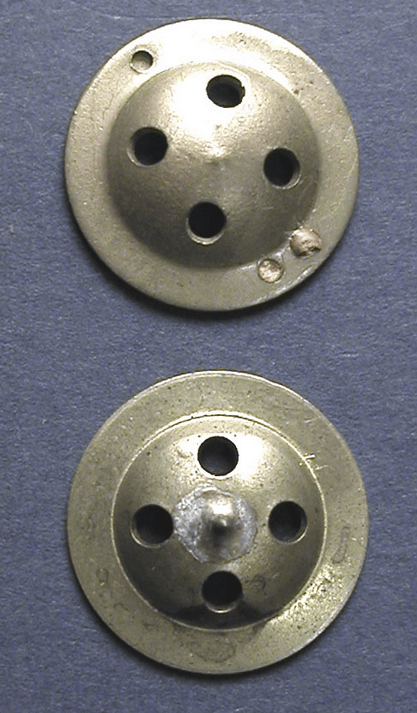
Wikimediahttps://www.iwm.org.uk/collections/item/object/30081304. From Auckland Museum. “WW2 escaper’s button compass issued to the Royal Australian Air Force The same type of compass was issued to New Zealand and UK aircrew The compass takes the form of two buttons; these were generally used as buttons on the fly of their battledress pants. When removed the buttons position together to form a compass.”
However, WW2 was not the first time these were used …
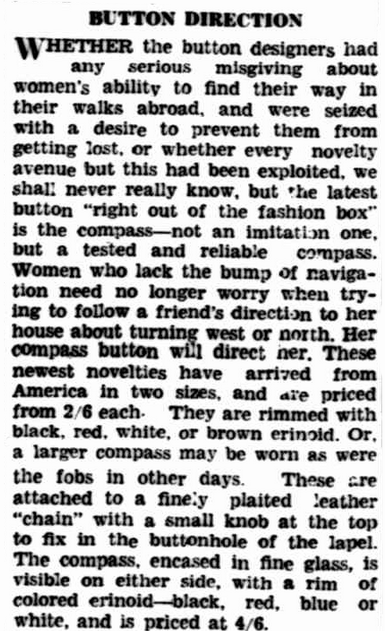
The Advertiser (Adelaide), 8th May 1936 page 9.
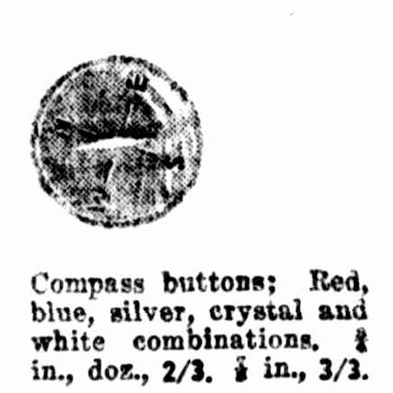
The Sun (Sydney), 23rd August 1936 page 8. For sale at Farmer’s.
Buttons made from coins
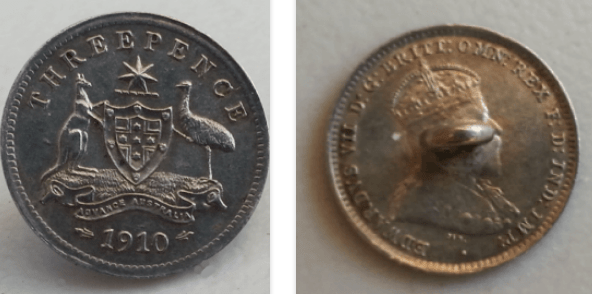
This button is made from a mint condition silver 1910 King Edward VII threepence. I wondered at that, as it is illegal to deface/alter current Australian currency. However, this was the year the King died. I presume there were some un-issued coins that could legitimately be made into commemorative waistcoat buttons.
Commonwealth Games
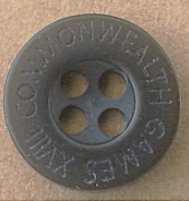
This button is from the XVIII Games that were held in Melbourne in 2006. The button come from clothing sold as merchandising for the Games.
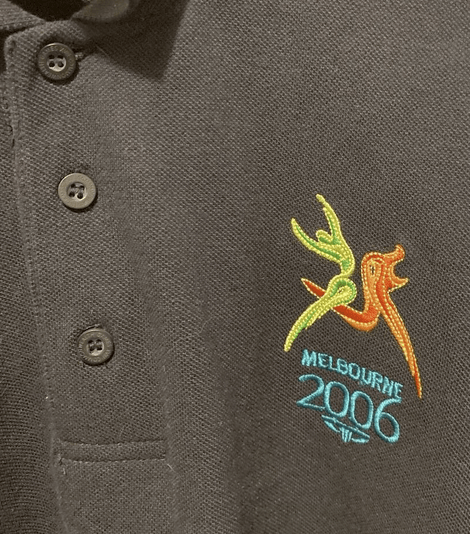
Detail from a polo shirt.
Feves/King Cake Charms
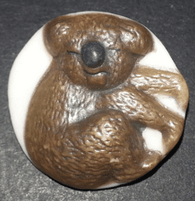
A koala button Feve.
Feves (French for “bean”) are tiny figurines that are made to be put inside a “King’s Cake” for the “Epiphany” Holiday, which is celebrated every year on January 6th, known as the 12th day of Christmas. Tradition states that this is the day that the three wise men or “Three Kings” came to Bethlehem to honor the birth of Christ. Traditionally it was a fava bean (Ed: known here as broad beans) that was placed inside the cake. Whoever finds the feve in his or her slice of cake, is King for the day. Since it was good luck to get the feve/fava in your cake these little items were saved and treasured.
In the 1870s the bean was replaced with small porcelain figurines; good luck charms, religious figures, saints etc, and a collecting craze began! The oldest feves were porcelain. As the years sped by, designs became more elaborate. Different glazes were used. They could be hand painted or gilded. The tradition of feve production and collecting has been completely commercialized, and there is a vast assortment of porcelain, plastic and metal figures made. A lot of the newest feves are sold in series – more for collecting than for actually placing in cakes. Designs include everything from Harry Potter and Disney to the high fashion shoes and purses. Collecting feves is very popular in France. The series are generally only produced for a single year.”
Possible Matthew Flinders Bicentennial Button
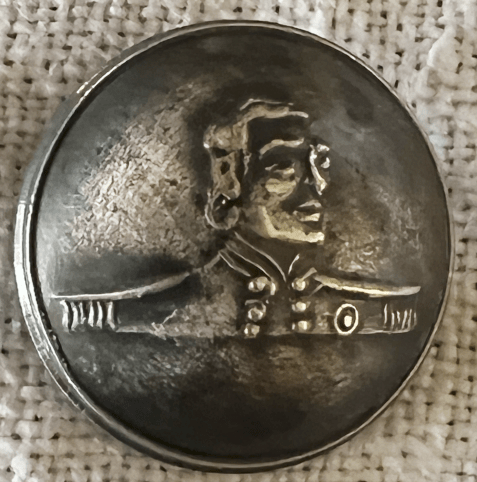
Backmark: Olson Adelaide
This company has been operating near Adelaide from 1966 as Allan J. Olson Pty. Ltd. making badges, medallions, name bars and uniform buttons. Allan Olson started as an apprentice in 1936 with S. Schlank & Co., working with them until 1965 then starting his own business. In 1971 he bought the former Schlank plant, equipment (including many old dies) and their factory located in Forrestville, South Australia.
In 1802 Matthew Flinders “discovered” South Australia (how very Eurocentric) during his circumnavigation of the continent. I presume this button was made to celebrate his achievement.

Matthew Flinders (1774-1814), by unknown artist, c1800 State Library of New South Wales, Original : MIN 52
Slouch Hat buttons/badges
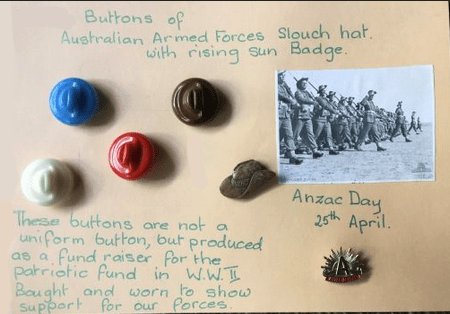
Carol’s collection.
Although these have been labelled these as a fund raiser from WW2, I suspect they may be post WW2 as I can find no WW2 era newspaper article about them, and fundraising “Button Days” were well covered in the media.

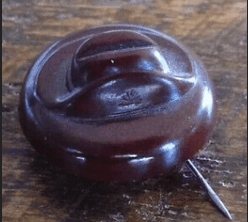
The slouch hat rests on a disk, with the ‘rising sun’ badge visible. On the back of the above brown example the shank has a pin through it, and this may have been the designed purpose. (Perhaps it could be used both as a badge or as a button with the pin removed.)
These may have been similar fundraising items as the “tin hat” badges sold by the Returned Soldiers League from 1929-1970. Another alternative is that they are ‘patriotic’ fashion buttons.
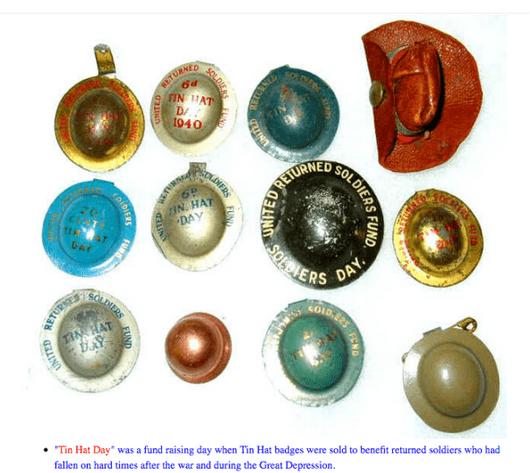
This image is from http://www.diggerhistory.info/pages-badges/pins4.htm
The slouch hat was first worn by the Victorian Volunteer Rifles in 1885. One side of the brim slouched down slightly, whilst the other side was cocked up and held in place with what became known as the Rising Sun badge. This kept the brim out of the way when shouldering a rifle.
Unofficial Uniform Buttons:
Versions of the ‘Rising Sun’ design have been used for the Army’s badge since 1904, although the rising sun element appears as early as 1858 on tokens, and even earlier as a symbol used by Australian organisations. See these links for more information.
https://en.wikipedia.org/wiki/Rising_Sun_(badge)
http://www.diggerhistory.info/pages-badges/rising_sun.htm
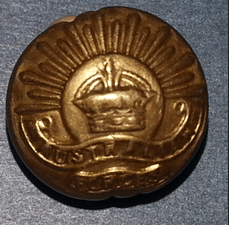
My example
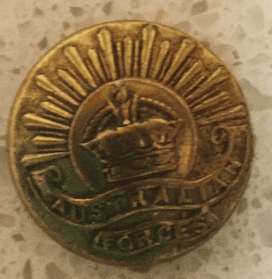
Another example
However, it has not been used on official button i.e. Government approved designs. The demand for uniforms, buttons and the like were so urgent and overwhelming at the start of some conflicts that a market for such unofficial mechandise must have existed. My buttons is rather battered, including a soldered repair on the back. It was probably clamped to enable the repair, which dented the top and bottom edges! It has no makers back-mark. The crown shows considerable wear from polishing, so it was well used.
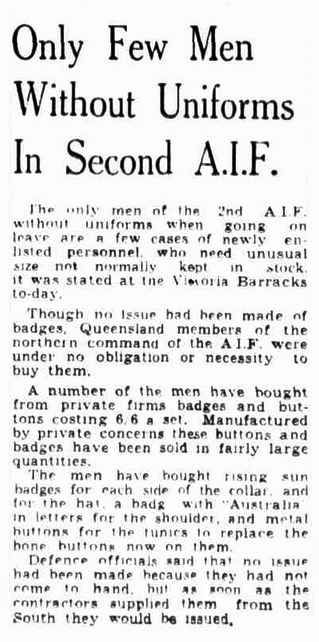
The Telegraph (Brisbane), 30th November 1939 page 5.
Whale tooth button
With permission from the Australian National Maritime Museum: a whale tooth button: check out https://www.sea.museum/ ;there is a lot to browse online.
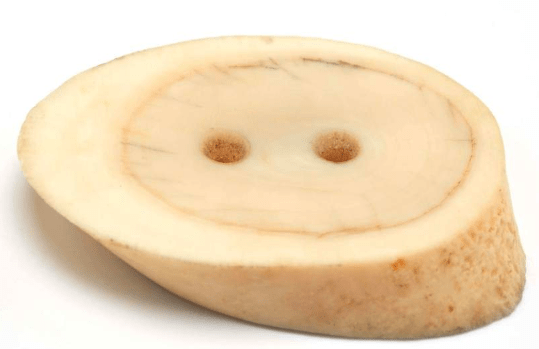
According to the museum : “A whale tooth button most likely made from a whale caught in waters off South Australia. Whalebone was a popular medium used to make decorative and functional items as it was both strong and yet able to be polished and carved.” Note that the museum uses both the terms tooth and bone, which is a little confusing. If they are from teeth then they may be from sperm whales, which are the largest of the toothed whales in Australian waters.
Emu Leather Button
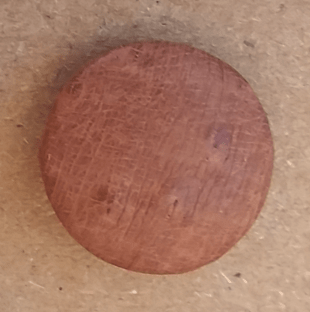
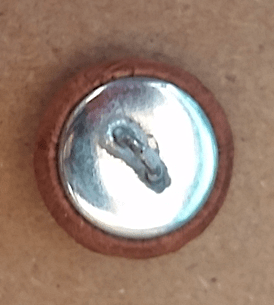
This approximately 15mm diametre covered button by Jan and Annette Pollard as part of their Jaemu fashion brand, is made of emu leather ‘grown’ in Wagga Wagga and tanned at Botany Bay. I cannot find any trace of this brand.
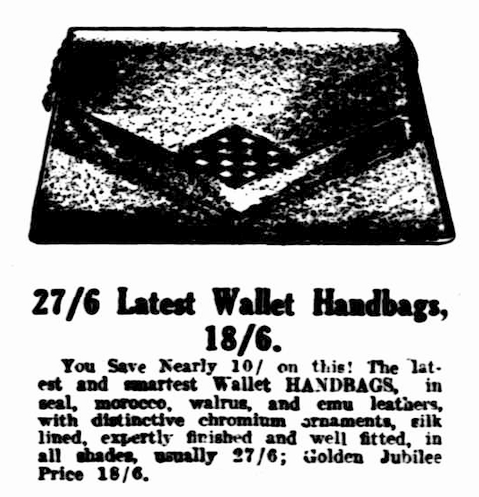
The West Australian (Perth), 3rd November 1933 page 11.
Emu were sometimes used to make cloaks worn by Koori peoples. The feathers were used for decorating hair, as well as for skirts made from plant fibres. They were worn as ornamental tufts on various parts of the body. A spear with a few emu feathers fixed could mark a grave.
Emu leather was not mentioned in newspapers until 1933-4, when various stores started selling handbags made from it. It can be a very fine and attractive product. Emu farming for leather was pioneered, unsuccessfully, in West Australia in 1970. Further attempts occurred, sometimes within Aboringinal communities, with the first export licence for emu products (mainly meat, oil and leather) granted in 1990. Larger numbers of emu were/are farmed in America, Canada, Europe, India, China and New Zealand than in Australia! Farming numbers have sharply declined as the cost of keeping them, the space they require, and processing issues, have proved problematic.
Emu feathers, as opposed to leathers, had a longer history of use by non-Koori Australians. Explorer Major Mitchell and his men wore emu and cockatoo feathers in their caps in 1836. Emu feathers were amongst produce donated to the new Trade Museum in London in 1854.


